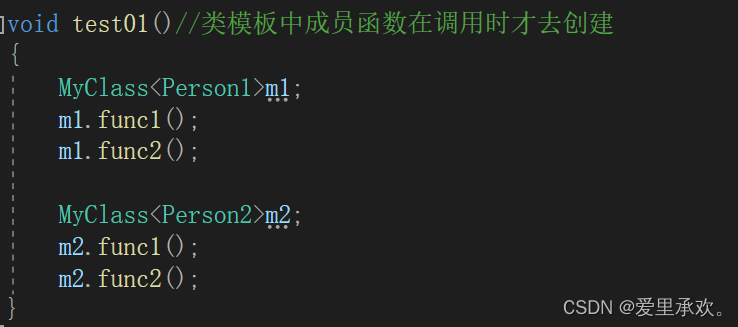【C++提高编程(一)】
·本阶段主要针对C++泛型编程和STL技术做详细讲解,探讨C++更深层的使用
一、模板
1.1、模板的概念
模板就是建立通用的模具,大大提高复用性
例如生活中的模板
一寸照片模板:?
PPT模板:?

模板的特点:
·模板不可以直接使用,它只是一个框架
·模板的通用并不是万能的
1.2、函数模板
·C++另一种编程思想称为泛型编程,主要利用的技术就是模板
·C++提供两种模板机制:函数模板和类模板
1.2.1、函数模板语法
函数模板作用:
建立一个通用函数,其函数返回值类型和形参类型可以不具体制定,用一个虚拟的类型来代表。?
语法:
template<typename T>
函数声明或定义
解释:
template --- 声明创建模板
typename --- 表面其后面的符号是一种数据类型,可以用class代替
T --- 通用的数据类型,名称可以替换,通常为大写字母
//交换两个整形函数
void swapInt(int& a, int& b)
{
int temp = a;
a = b;
b = temp;
}
//交换两个浮点型函数
void swapDouble(double& a, double& b)
{
double temp = a;
a = b;
b = temp;
}
//函数模板
template <typename T> //声明一个模板,告诉编译器后面代码中紧跟着的T不要报错,T是一个通用数据类型
void mySwap(T& a, T& b)
{
T temp = a;
a = b;
b = temp;
}
void test01()
{
int a = 10;
int b = 20;
//swapInt(a, b);
//利用函数模板来实现交换
//两种方式使用函数模板
//1.自动类型推导
mySwap(a, b);
cout << "a = " << a << endl << "b = " << b << endl;
double c = 1.1;
double d = 2.2;
//swapDouble(c, d);
//2.显示指定类型
mySwap<double>(c, d);
cout << "c = " << c << endl << "d = " << d << endl;
}
int main()
{
test01();
system("pause");
return 0;
}
总结:
·函数模板利用关键字 template
·使用函数模板有两种方式: 自动类型推导、显示指定类型
·模板的目的是为了提高复用性,将类型参数化
1.2.2、函数模板注意事项
注意事项:
·自动类型推导,必须推导出一致的数据类型T,才可以使用
·模板必须要确定出T的数据类型,才可以使用?
示例:
//函数模板注意事项
template <class T> //typename可以替换成class
void mySwap(T& a, T& b)
{
T temp = a;
a = b;
b = temp;
}
void test01()
{
//1.自动类型推导,必须推导出一致的数据类型T才可以使用
int a = 10;
int b = 20;
char c = 0;
mySwap(a, b);
//mySwap(a, c);//err
cout << "a = " << a << endl << "b = " << b << endl;
}
template <class T>
void func()
{
cout << "func()调用" << endl;
}
void test02()
{
//2.模板必须要确定出T的数据类型才可以使用
func<int>();
}
int main()
{
test01();
test02();
system("pause");
return 0;
}
总结:?
·使用模板时必须确定出通用数据类型T,并且能够推导出一致的类型?
1.2.3、函数模板案例
案例描述:
·利用函数模板封装一个排序的函数,可以对不同数据类型数组进行排序
·排序规则从大到小,排序算法为选择排序
·分别利用char数组和和int数组进行测试?
示例:?
//交换函数模板
template <class T>
void mySwap(T& a, T& b)
{
T temp = a;
a = b;
b = temp;
}
//排序算法
template <class T>
void mySort(T arr[] , int sz)
{
for (int i = 0; i < sz; i++)
{
int max = i;//认定最大值的下标
for (int j = i+1; j < sz; j++)
{
//认定的最大值比遍历出的数值要小,说明j下标的元素才是真正的最大值
if (arr[max] < arr[j])
{
max = j;//更新最大值下标
}
}
if (max != i)
{
//交换max和i的元素
mySwap(arr[max], arr[i]);
}
}
}
//提供打印数组的模板
template <class T>
void printArray(T arr[], int sz)
{
for (int i = 0; i < sz; i++)
{
cout << arr[i] << " ";
}
cout << endl;
}
void test01()
{
//测试char数组
char charArr[] = "badcfe";
int sz = sizeof(charArr) / sizeof(charArr[0]);
mySort(charArr, sz);
printArray(charArr, sz);
}
void test02()
{
//测试int数组
int intArr[] = {7,5,1,3,2,4,9,6};
int sz = sizeof(intArr) / sizeof(intArr[0]);
mySort(intArr, sz);
printArray(intArr, sz);
}
int main()
{
test01();
test02();
system("pause");
return 0;
}1.2.4、普通函数与函数模板的区别
普通函数与函数模板区别:
·普通函数调用时可以发生自动类型转换 (隐式类型转换)
·函数模板调用时,如果利用自动类型推导,不会发生隐式类型转换?
·如果利用显示指定类型的方式,可以发生隐式类型转换
示例:
//普通函数 - 可以发生隐式类型转换
int myAdd01(int a, int b)
{
return a + b;
}
//函数模板
template <class T>
T myAdd02(T a, T b)
{
return a + b;
}
void test01()
{
int a = 10;
int b = 20;
char c = 'c';//a - 97 c - 99
cout << myAdd01(a, c) << endl;
//自动类型推导 - 不可以发生隐式类型转换
cout << myAdd02(a,b) << endl;
//显式指定类型 - 可以发生隐式类型转换
cout << myAdd02<int>(a, c) << endl;
}
int main()
{
test01();
system("pause");
return 0;
}
总结: 建议使用显示指定类型的方式,调用函数模板,因为可以自己确定通用类型T
1.2.5、普通函数与函数模板的调用规则
调用规则如下:
1.如果函数模板和普通函数都可以实现,优先调用普通函数
2.可以通过空模板参数列表来强制调用函数模板
3.函数模板也可以发生重载
4.如果函数模板可以产生更好的匹配,优先调用函数模板
示例:
void myPrint(int a, int b)
{
cout << "调用的普通函数" << endl;
}
template <class T>
void myPrint(T a, T b)
{
cout << "调用的模板函数" << endl;
}
template <class T>
void myPrint(T a, T b , T c)
{
cout << "调用重载的模板函数" << endl;
}
void test01()
{
int a = 10;
int b = 20;
myPrint(a, b);//如果函数模板和普通函数均可调用.优先调用普通函数
//通过空模板的函数列表,强制调用函数模板
myPrint<>(a, b);
myPrint(a, b, 100);
//如果函数模板产生更好的匹配,优先调用函数模板
char c1 = 'a';
char c2 = 'b';
myPrint(c1, c2);
}
int main()
{
test01();
system("pause");
return 0;
} 总结:既然提供了函数模板,最好就不要提供普通函数,否则容易出现二义性
总结:既然提供了函数模板,最好就不要提供普通函数,否则容易出现二义性
1.2.6、模板的局限性
局限性:
·模板的通用性并不是万能的
例如:?
template<class T>
void f(T a, T b)
{
????????a = b;
}
在上述代码中提供的赋值操作,如果传入的a和b是一个数组,就无法实现了?
再例如:
template<class T>
void f(T a, T b)
{
????????if(a > b){?... }
}
在上述代码中,如果T的数据类型传入的是像Person这样的自定义数据类型,也无法正常运行?
因此C++为了解决这种问题,提供模板的重载,可以为这些特定的类型提供具体化的模板
class Person
{
public:
int m_Age;
string m_Name;
public:
Person(string name , int age)
{
this->m_Name = name;
this->m_Age = age;
}
};
//对比两个数据是否相等的函数
template <class T>
bool myCompare(T& a, T& b)
{
if (a == b)
{
return true;
}
else
{
return false;
}
}
//利用具体化Person的 版本实现代码,具体化优先调用
template<> bool myCompare(Person& p1, Person& p2)
{
if (p1.m_Name == p2.m_Name && p1.m_Age == p2.m_Age)
{
return true;
}
return false;
}
void test01()
{
int a = 10;
int b = 20;
bool ret1 = myCompare(a, b);
if (ret1 == true)
{
cout <<"a和b相等!" << endl;
}
else
{
cout << "a和b不相等!" << endl;
}
Person p1("Tom", 10);
Person p2("Tom", 10);
bool ret2 = myCompare(p1, p2);
if (ret2 == true)
{
cout << "p1和p2相等!" << endl;
}
else
{
cout << "p1和p2不相等!" << endl;
}
}
int main()
{
test01();
system("pause");
return 0;
}
总结:
·利用具体化的模板,可以解决自定义类型的通用化
·学习模板并不是为了写模板,而是在STL能够运用系统提供的模板?
1.3、类模板
1.3.1、类模板语法
类模板作用:
·建立一个通用类,类中的成员、数据类型可以不具体制定,用一个虚拟的类型来代表。
语法:
template<typename T>
类
解释:
template --- 声明创建模板
typename --- 表面其后面的符号是一种数据类型,可以用class代替
T --- 通用的数据类型,名称可以替换,通常为大写字母?
示例:
//类模板
template<class NameType , class AgeType>
class Person
{
public:
NameType m_Name;
AgeType m_Age;
Person(NameType name, AgeType age)
{
this->m_Name = name;
this->m_Age = age;
}
void showPerson()
{
cout << "姓名:" << this->m_Name << " 年龄:" << this->m_Age << "岁" << endl;
}
};
void test01()
{
Person<string, int>p1("孙悟空", 999);
p1.showPerson();
}
int main()
{
test01();
system("pause");
return 0;
}总结: 类模板和函数模板语法相似,在声明模板template后面加类,此类称为类模板
1.3.2、类模板与函数模板区别
类模板与函数模板区别主要有两点:
1.类模板没有自动类型推导的使用方式
2.模板在模板参数列表中可以有默认参数?
示例:?
//类模板
template<class NameType, class AgeType = int>
class Person
{
public:
NameType m_Name;
AgeType m_Age;
Person(NameType name, AgeType age)
{
this->m_Name = name;
this->m_Age = age;
}
void showPerson()
{
cout << "姓名:" << this->m_Name << " 年龄:" << this->m_Age << "岁" << endl;
}
};
void test01()
{
//1.类模板没有自动类型推导的使用方式
//Person p("孙悟空", 999);//err
Person <string, int>p1("孙悟空", 1000);//只能用显示指定类型
p1.showPerson();
//2.类模板在模板参数列表中可以有默认参数
Person <string, int>p2("猪八戒", 999);
p2.showPerson();
}
int main()
{
test01();
system("pause");
return 0;
}总结:
·类模板使用只能用显示指定类型方式
·类模板中的模板参数列表可以有默认参数?
1.3.3、类模板中成员函数创建时机
类模板中成员函数和普通类中成员函数创建时机是有区别的:
·普通类中的成员函数一开始就可以创建
·类模板中的成员函数在调用时才创建
示例:?
class Person1
{
public:
void showPerson1()
{
cout << "Person1 show" << endl;
}
};
class Person2
{
public:
void showPerson2()
{
cout << "person2 show" << endl;
}
};
template<class T>
class MyClass
{
public:
T obj;
//类模板中的成员函数
void func1()
{
obj.showPerson1();
}
void func2()
{
obj.showPerson2();
}
};
void test01()//类模板中成员函数在调用时才去创建
{
MyClass<Person1>m1;
m1.func1();
//m1.func2();
MyClass<Person2>m2;
//m2.func1();
m2.func2();
}
int main()
{
test01();
system("pause");
return 0;
}


总结: 类模板中的成员函数并不是一开始就创建的,在调用时才去创建
1.3.4、类模板对象做函数参数
学习目标:
·类模板实例化出的对象,向函数传参的方式
一共有三种传入方式:
1.指定传入的类型 --- 直接显示对象的数据类型
2.参数模板化 --- 将对象中的参数变为模板进行传递
3.整个类模板化 --- 将这个对象类型,模板化进行传递
示例:
template <class T1 , class T2>
class Person
{
public:
T1 m_Name;
T2 m_Age;
Person(T1 name, T2 age)
{
this->m_Name = name;
this->m_Age = age;
}
void showPerson()
{
cout << "姓名:" << this->m_Name << " 年龄:" << this->m_Age << endl;
}
};
//1.指定传入类型
void printPerson1(Person<string, int>&p)
{
p.showPerson();
}
//2.参数模板化 - 函数模板配合类模板
template <class T1, class T2>
void printPerson2(Person<T1, T2>& p)
{
p.showPerson();
cout << "T1的类型为:" << typeid(T1).name() << endl;
cout << "T2的类型为:" << typeid(T2).name() << endl;
}
//3.整个类模板化 - 函数模板配合类模板
template <class T>
void printPerson3(T &p)
{
p.showPerson();
cout << "T的类型为:" << typeid(T).name() << endl;
}
void test01()
{
Person<string, int>p1("孙悟空", 999);
printPerson1(p1);
Person<string, int>p2("猪八戒", 599);
printPerson2(p2);
Person<string, int>p3("唐僧", 36);
printPerson3(p3);
}
int main()
{
test01();
system("pause");
return 0;
}
总结:
·通过类模板创建的对象,可以有三种方式向函数中进行传参
·使用比较广泛的是第一种:指定传入的类型?
1.3.5、类模板与继承
当类模板碰到继承时,需要注意一下几点:
·当子类继承的父类是一个类模板时,子类在声明的时候,要指定出父类中T的类型
·如果不指定,编译器无法给子类分配内存
·如果想灵活指定出父类中T的类型,子类也需变为类模板
示例:
template<class T>
class Base
{
T m;
};
//class Son :public Base//err - 必须知道父类中T的类型,才能继承给子类
class Son1 :public Base<int>
{
};
//如果想灵活的指定父类中T类型,子类也需要变为类模板
template <class T1 , class T2>
class Son2 :public Base<T2>
{
public:
Son2()
{
cout << "T1的数据类型:" << typeid(T1).name() << endl;
cout << "T2的数据类型:" << typeid(T2).name() << endl;
}
T1 obj;
};
void test01()
{
Son2<int, char> s2;
}
int main()
{
test01();
system("pause");
return 0;
}
总结:如果父类是类模板,子类需要指定出父类中T的数据类型?
1.3.6、类模板成员函数类外实现
学习目标:能够掌握类模板中的成员函数类外实现
示例:
template <class T1 , class T2>
class Person
{
public:
T1 m_Name;
T2 m_Age;
Person(T1 name, T2 age);
//{
// this->m_Name = name;
// this->m_Age = age;
//}
void showPerson();
//{
// cout << "姓名:" << this->m_Name << " 年龄:" << this->m_Age << endl;
//}
};
//构造函数类外实现
template <class T1, class T2>
Person<T1,T2>::Person(T1 name, T2 age)
{
this->m_Name = name;
this->m_Age = age;
}
//成员函数类外实现
template <class T1, class T2>
void Person<T1, T2>::showPerson()
{
cout << "姓名:" << this->m_Name << " 年龄:" << this->m_Age << endl;
}
void test01()
{
Person<string, int>p("奥特曼", 137);
p.showPerson();
}
int main()
{
test01();
system("pause");
return 0;
}总结:类模板中成员函数类外实现时,需要加上模板参数列表
1.3.7、类模板分文件编写
学习目标:
·掌握类模板成员函数分文件编写产生的问题以及解决方式
问题:
·类模板中成员函数创建时机是在调用阶段,导致分文件编写时链接不到
解决:
·解决方式1:直接包含.cpp源文件
·解决方式2:将声明和实现写到同一个文件中,并更改后缀名为.hpp,hpp是约定的名称,并不是强制
示例:
person.hpp中代码:
#pragma once
#include<iostream>
using namespace std;
template <class T1, class T2>
class Person
{
public:
T1 m_Name;
T2 m_Age;
Person(T1 name, T2 age);
void showPerson();
};
template <class T1, class T2>
Person<T1, T2>::Person(T1 name, T2 age)
{
this->m_Name = name;
this->m_Age = age;
}
template <class T1, class T2>
void Person<T1, T2>::showPerson()
{
cout << "姓名:" << this->m_Name << " 年龄:" << this->m_Age << endl;
}类模板分文件编写.cpp中代码:
#include"Person.h"
template <class T1, class T2>
Person<T1,T2>::Person(T1 name, T2 age)
{
this->m_Name = name;
this->m_Age = age;
}
template <class T1, class T2>
void Person<T1, T2>::showPerson()
{
cout << "姓名:" << this->m_Name << " 年龄:" << this->m_Age << endl;
}?test.cpp:
//类模板分文件编写的问题(无法解析的外部命令) - 类模板的成员函数创建时机是在调用阶段,一开始不创建,调用时才创建
//第一种解决方式 - 直接包含源文件
//#include "Person.cpp"//将#include "Person.h" 替换成 #include "Person.cpp"
//第二种解决方式 - 将.h和.cpp中的内容写到一起,将后缀名改为.hpp文件
#include"Person.hpp"
void test01()
{
Person<string, int>p("奥特曼", 137);
p.showPerson();
}
int main()
{
test01();
system("pause");
return 0;
}总结:主流的解决方式是第二种,将类模板成员函数写到一起,并将后缀名改为.hpp
1.3.8、类模板与友元
学习目标:
·掌握类模板配合友元函数的类内和类外实现
全局函数类内实现 - 直接在类内声明友元即可
全局函数类外实现 - 需要提前让编译器知道全局函数的存在?
示例:
//提前让编译器知道Person类的存在
template <class T1, class T2>
class Person;
//类外实现
template <class T1, class T2>
void showPerson2(Person<T1, T2> p)
{
cout << "类外实现 --- 姓名:" << p.m_Name << " 年龄:" << p.m_Age << endl;
}
template <class T1, class T2>
class Person
{
//全局函数类内实现
friend void showPerson1(Person<T1 , T2> p)
{
cout << "类内实现 --- 姓名:" << p.m_Name << " 年龄:" << p.m_Age << endl;
}
//全局函数类外实现
//加空模板参数列表
//如果全局函数是类外实现,需要让编译器提前知道这个函数的存在
friend void showPerson2<>(Person<T1, T2> p);
public:
Person(T1 name, T2 age)
{
this->m_Name = name;
this->m_Age = age;
}
private:
T1 m_Name;
T2 m_Age;
};
void test01()
{
//1.全局函数在类内实现
Person<string, int>p1("Tom", 6);
showPerson1(p1);
//1.全局函数在类外实现
Person<string, int>p2("Jerry", 2);
showPerson2(p2);
}
int main()
{
test01();
system("pause");
return 0;
}
总结:建议全局函数做类内实现,用法简单,而且编译器可以直接识别?
1.3.9、类模板案例
案例描述:实现一个通用的数组类,要求如下:
·可以对内置数据类型以及自定义数据类型的数据进行存储
·将数组中的数据存储到堆区
·构造函数中可以传入数组的容量
·提供对应的拷贝构造函数以及operator=防止浅拷贝问题
·提供尾插法和尾删法对数组中的数据进行增加和删除。
·可以通过下标的方式访问数组中的元素
·可以获取数组中当前元素个数和数组的容量
示例:
myArray.hpp中代码:
//自己通用的数组类
#pragma once
#include <iostream>
using namespace std;
template <class T>
class MyArray
{
private:
T* pAddress;//指针指向堆区开辟的真实数组
int m_Capacity;//数组容量
int m_Size;//数组大小
public:
//有参构造 - 参数:容量
MyArray(int capacity)
{
//cout << "MyArray的有参构造" << endl;
this->m_Capacity = capacity;
this->m_Size = 0;
this->pAddress = new T[this->m_Capacity];
}
//拷贝构造
MyArray(const MyArray& arr)
{
//cout << "MyArray的拷贝构造" << endl;
this->m_Capacity = arr.m_Capacity;
this->m_Size = arr.m_Size;
//this->pAddress = arr.pAddress;
this->pAddress = new T[arr.m_Capacity];//深拷贝
//将arr中数据都拷贝过来
for (int i = 0; i < this->m_Size; i++)
{
this->pAddress[i] = arr.pAddress[i];
}
}
//operator= 防止浅拷贝问题
MyArray& operator=(const MyArray& arr)
{
//cout << "MyArray的operator函数" << endl;
//先判断原理堆区是否有数据,如果有,先释放
if (this->pAddress != NULL)
{
delete[] this->pAddress;
this->pAddress = NULL;
this->m_Capacity = 0;
this->m_Size = 0;
}
//深拷贝
this->m_Capacity = arr.m_Capacity;
this->m_Size = arr.m_Size;
this->pAddress = new T[arr.m_Capacity];
for (int i = 0; i < this->m_Size; i++)
{
this->pAddress[i] = arr.pAddress[i];
}
return *this;
}
//尾插法
void Push_Bace(const T& val)
{
//判断容量是否等于大小
if (this->m_Size == this->m_Capacity)
{
return;
}
this->pAddress[this->m_Size] = val;//在数组末尾插入数据
this->m_Size++;//更新数组大小
}
//尾删法
void Pop_Back()
{
//让用户访问不到最后一个元素,即为尾删,逻辑删除
if (this->m_Size == 0)
{
return;
}
this->m_Size--;
}
//通过下标的方式来访问数组中元素 - arr[0] = 100(不仅可以取出第xx号元素,还可以作为左值存在)
T& operator[](int index)
{
return this->pAddress[index];
}
//返回数组容量
int getCapacity()
{
return this->m_Capacity;
}
//返回数组大小
int getSize()
{
return this->m_Size;
}
//析构函数
~MyArray()
{
//cout << "MyArray的析构函数" << endl;
if (this->pAddress != NULL)
{
delete[] this->pAddress;
this->pAddress = NULL;
}
}
};类模板案例 --- 数组类封装.cpp中:
#include "MyArray.hpp"
void printIntArray(MyArray<int>& arr)
{
for (int i = 0; i < arr.getSize(); i++)
{
cout << arr[i] << " ";
}
cout << endl;
}
void test01()
{
MyArray<int> arr1(5);
for (int i = 0; i < 5; i++)
{
//利用尾插法向数组中插入数据
arr1.Push_Bace(i);
}
cout << "arr1的打印输出为:";
printIntArray(arr1);
cout << "arr1的容量:" << arr1.getCapacity() << endl;
cout << "arr1的大小:" << arr1.getSize() << endl;
MyArray<int> arr2(arr1);
cout << "arr2的打印输出为:";
printIntArray(arr2);
//尾删
arr2.Pop_Back();
cout << "arr2尾删后:" << endl;
cout << "arr2的容量:" << arr2.getCapacity() << endl;
cout << "arr2的大小:" << arr2.getSize() << endl;
//MyArray<int> arr2(arr1);
//MyArray<int> arr3(100);
//arr3 = arr1;
}
//测试自定义数据类型
class Person
{
public:
string m_Name;
int m_Age;
Person() {};
Person(string name, int age)
{
this->m_Name = name;
this->m_Age = age;
}
};
void printPersonArray(MyArray<Person>& arr)
{
for (int i = 0; i < arr.getSize(); i++)
{
cout << "姓名:" << arr[i].m_Name << " 年龄:" << arr[i].m_Age << endl;
}
}
void test02()
{
MyArray<Person> arr(10);
Person p1("孙悟空", 999);
Person p2("牛魔", 987);
Person p3("韩信", 20);
Person p4("妲己", 500);
Person p5("安其拉", 200);
//将数据插入到数组中
arr.Push_Bace(p1);
arr.Push_Bace(p2);
arr.Push_Bace(p3);
arr.Push_Bace(p4);
arr.Push_Bace(p5);
//打印数组
printPersonArray(arr);
//输出容量
cout << "arr的容量:" << arr.getCapacity() << endl;
//输出大小
cout << "arr的大小:" << arr.getSize() << endl;
}
int main()
{
//test01();
test02();
system("pause");
return 0;
}
 ?
?

 ?
?
总结:能够利用所学知识点实现通用的数组
本文来自互联网用户投稿,该文观点仅代表作者本人,不代表本站立场。本站仅提供信息存储空间服务,不拥有所有权,不承担相关法律责任。 如若内容造成侵权/违法违规/事实不符,请联系我的编程经验分享网邮箱:chenni525@qq.com进行投诉反馈,一经查实,立即删除!
